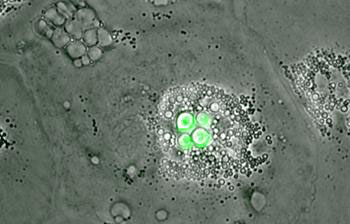New Insights into the Avian Immune System Explain the Transmission of a Deadly Fungal Infection
By LabMedica International staff writers
Posted on 01 Mar 2016
A team of British immunologists has discovered how birds, which spread the deadly fungus Cryptococcus neoformans, avoid being killed by the pathogen.Posted on 01 Mar 2016
Investigators at the University of Sheffield (United Kingdom) worked with a pure population of primary bird macrophages to study the interaction of C. neoformans with the bird immune system.

Image: The photomicrograph shows bird macrophages infected with the fungal pathogen Cryptococcus neoformans (green) (Photo courtesy of the University of Sheffield).
They reported in the February 17, 2016, online edition of the journal Scientific Reports that at avian body temperatures bird macrophages strongly suppressed fungal growth, but a small proportion of the fungal cell population escaped killing. Bird macrophages were able to suppress the growth of the type of cryptococci seen in mammalian cells despite C. neoformans being able to grow at bird body temperature.
A small subset of cryptococci became adapted to the inhibitory intracellular environment of bird macrophages and was able to escape from it by vomocytosis (the cellular process by which live organisms that have previously been engulfed by a white blood cell are expelled without being destroyed). Thus, birds were shown to harbor low numbers of cryptococci for prolonged periods without developing the disease and were able to act as vectors of the human disease via viable parasites deposited in the guano.
First author Dr. Simon Johnston, MRC career development fellow in the department of infection, immunity, and cardiovascular disease at the University of Sheffield, said, "By studying bird cells under the microscope, we have seen that macrophage cells have the ability to completely block the growth of the fungus, which can be fatal in humans. Birds have a higher body temperature than humans, 42 degrees Celsius instead of 37 degrees Celsius, but this alone is not enough to fully stop the fungus.
Many human diseases are spread by birds, but we know surprisingly little about their immune systems. Discovering how they resist otherwise fatal infections offers the hope of improving our ability to intervene in this cycle and prevent a diverse range of human diseases."
Related Links:
University of Sheffield













